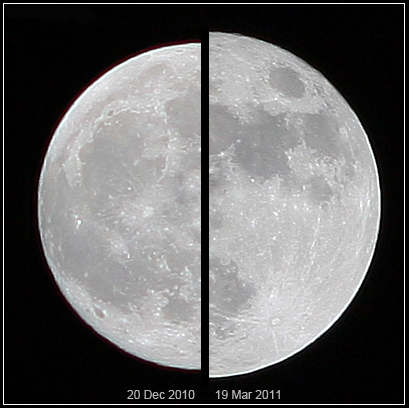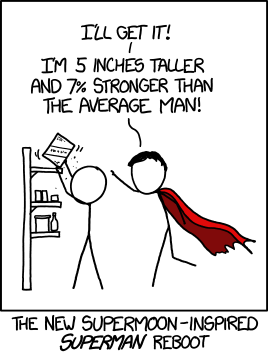Let's start simple, with what it means to have a Full Moon. All this means is that the Moon is in the point of its orbit around the Earth which puts it directly opposite the Sun in the sky. As a result the side of the Moon we see is fully illuminated by the Sun, and the Moon rises at sunset (and sets at sunrise) making it visible all night.
 |
| Diagram illustrating how the phase of the Moon depends on its position in its orbit around the Earth relative to the location of the Sun. In this diagram the Sun is not shown, but it is to the right, directly above the point on the Earth labelled "Noon". Credit: Wikimedia, Thomas Splettstoesser. |
This difference is very small - much smaller than shown in the diagram above. If I drew an oval with the right proportions you couldn't tell it wasn't a circle! The mean distance to the Moon is 384,400 km, the closest approach is just 21,296 km closer than this. That might sound a lot, but it's just 5% closer than the average (an apogee is 5% more distant than average).
A Supermoon is just the name we give for a Full Moon which happens when the Moon is at or close to perigee (i.e. it's closest point to the Earth). Being 5% closer than average makes the Moon look a barely noticeable 5% larger, however the impact on its brightness is more significant, making Supermoons the spectacle that gets attention. A Supermoon will be 30% brighter than a Full Moon at apogee. High and low tides will also be more extreme when the Moon is closer.
 |
| The Supermoon of 19th March 2011 (right) compared to an average full Moon (left). Credit: Wikimedia, Marco Langbroek. |
Now how close the Supermoon is to the exact point of perigee determines the exact distance to the Full Moon and how super the Supermoon is. The upcoming Full Moon happens at 3pm GMT, Monday 14th November 2016, when the Moon is within 1.5 hours of passing through perigee, making it a "super Supermoon".
What's more, the distance of lunar perigee also varies slightly (caused by the gravity of other planets in the Solar System and various resonances). The November 14th perigee happens to be a close one. This means that 14th November is really a super-dooper Supermoon; a lunar perigee hasn't happened so close to the Earth since January 26, 1948, and the next Full Moon which is so close will be November 25, 2034.
While these are relatively rare events, the noticeable difference in the Moon is quite small. The Full Moon is well worth catching every month, even if the nights of 13th/14th November 2016 ti will be slightly brighter and larger than average.
 |
| xkcd comic explaining the Supermoon. |
And be aware that Supermoons are getting gradually less super. The Moon is very slowly moving away from the Earth. However as it's moving away at just 3.8cm each year, it'll be a while (a few billion years) before this makes any noticeable difference.
.svg/852px-Apogee_(PSF).svg.png)